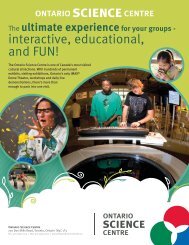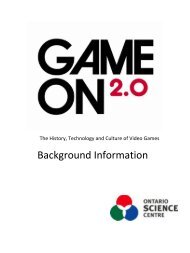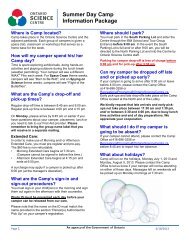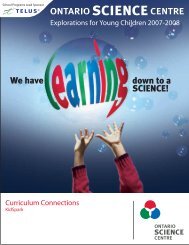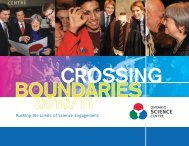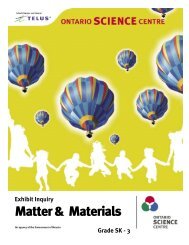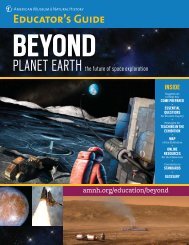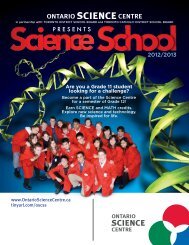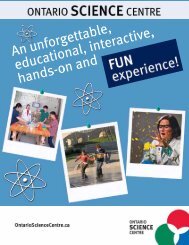STAR TREK LIVE! - Ontario Science Centre
STAR TREK LIVE! - Ontario Science Centre
STAR TREK LIVE! - Ontario Science Centre
Create successful ePaper yourself
Turn your PDF publications into a flip-book with our unique Google optimized e-Paper software.
Teachers Resource Manual<br />
Experiment: Your Body in Space<br />
6 Instructions for learning centers: Have group<br />
members take a learning center card and read<br />
the “did you know” fact, discuss the<br />
“discussion question,” perform the “try it out”<br />
experiment, and then read the “discuss<br />
findings” questions. Groups may elect a<br />
member to take notes on the learning center<br />
card. Advise that class will reconvene to<br />
discuss their findings after all groups visit the<br />
four learning centers.<br />
7 Assign each group to a learning center to begin<br />
the activities. Circulate to ensure that the<br />
groups are on-task and to answer any<br />
questions. Have the groups rotate after<br />
approximately 8 minutes.<br />
8 After the groups have explored each<br />
learning center, reconvene the class to discuss<br />
their findings (see explanation section for<br />
more details).<br />
spreading among group members. You can wash<br />
your hands before and after visiting the restroom,<br />
and cover your mouth and nose with a tissue<br />
when you cough or sneeze to keep germs from<br />
spreading.<br />
Muscles: Gravity on Earth pulls against us when<br />
we walk, run, and play. This makes our muscles<br />
work hard and keeps them strong. However,<br />
astronauts in space are affected by Earth’s gravity,<br />
so their muscles can weaken and waste away. This<br />
is why it is especially important for astronauts in<br />
space to exercise at least two hours daily.<br />
Astronauts in space do stretching and running<br />
exercises while strapped to a treadmill machine.<br />
Even if they workout in space, astronauts still<br />
experience muscle and bone loss and have to build<br />
them back when they return to Earth.<br />
Explanation<br />
Balance: Your brain uses information from the<br />
eyes, special parts of the inner ear, and sensors in<br />
the joints and skin to help you stay oriented and<br />
balanced. These touch and balance systems in<br />
space, unable to feel gravity’s effects, become<br />
temporarily confused. Astronauts often feel dizzy<br />
and even experience motion sickness at the beginning<br />
of the space mission until they adjust to their<br />
new environment.<br />
Bones: Astronauts’ bones in space become weak<br />
and porous, like the chicken bones in the vinegar,<br />
because they are not working against Earth’s<br />
gravity. Astronauts must be sure to eat foods that<br />
contain plenty of calcium and to do a lot of<br />
exercise to keep their bodies healthy and bones<br />
strong.<br />
Health: Living and working in space may make<br />
it easier for astronauts to become sick or develop<br />
diseases. Classrooms like spaceships are enclosed<br />
spaces where germs spread easily like the rice<br />
Your Body in Space<br />
19




